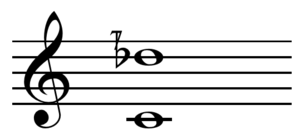Pseudo-octave

A pseudo-octave, pseudooctave,[1] or paradoxical octave[2] in music is an interval whose frequency ratio is not 2:1 (2.3:1[1] or 1.9:1, for example), that of the octave, but is perceived or treated as equivalent to this ratio, and whose pitches are considered equivalent to each other as with octave equivalency.
Stretched octave
The stretched octave, for example 2.01 : 1 , rather than 2 : 1 (an 8.6
In
The effect of strings' small
The practical consequence of the discrepancy between the sharpened pitches in a bass note's overtone series that treble notes must match, makes it necessary to widen every interval very slightly. Generally, it's more than sufficient to sharpen only whole octaves slightly, rather than separately modifying all intervals that reach individual pitches in the upper octaves (see stretched tuning).
The octaves of Balinese gamelans are never tuned 2:1, but instead are stretched or compressed in a consistent manner throughout the range of each individual gamelan, due to the physical characteristics of their instruments. [citation needed] Another example is the tritave ⓘ of the Bohlen–Pierce scale (3:1).
Octave stretching is less apparent on large pianos which have longer strings and hence less curvature for a given
See also
References
- ^ a b "Interview with Max Mathews", p.21. Author(s): C. Roads and Max Mathews. Source: Computer Music Journal, Vol. 4, No. 4, (Winter, 1980), pp. 15–22. Published by: The MIT Press.
- ^ "The Paradoxes of Octave Identities", p.213. Author(s): Jenő Keuler. Source: Studia Musicologica Academiae Scientiarum Hungaricae, T. 40, Fasc. 1/3, (1999), pp. 211–224. Published by: Akadémiai Kiadó.

